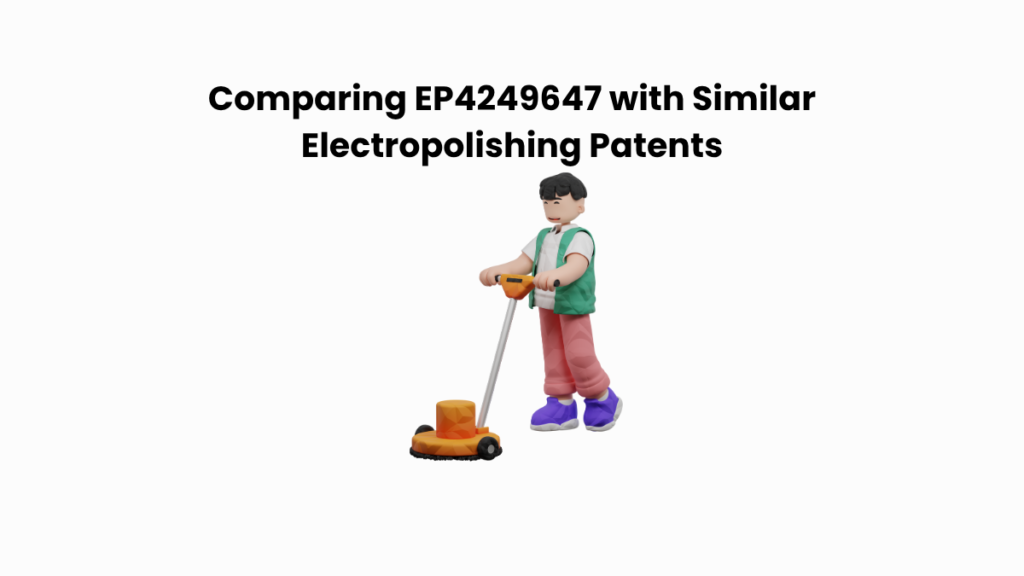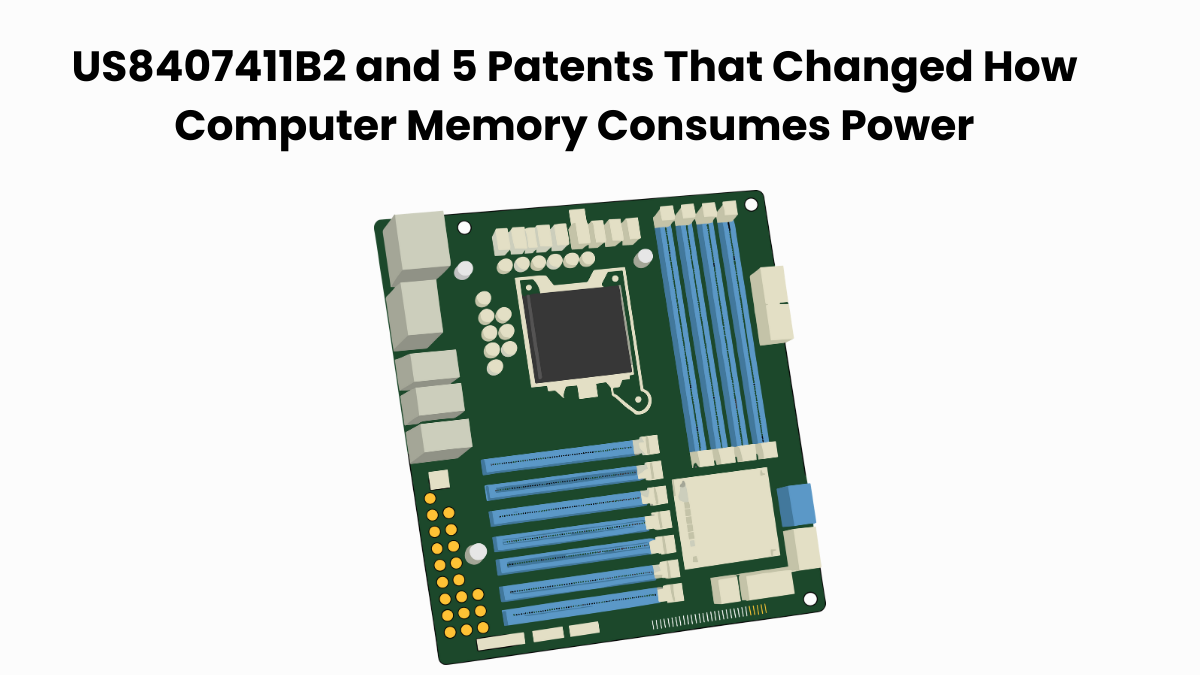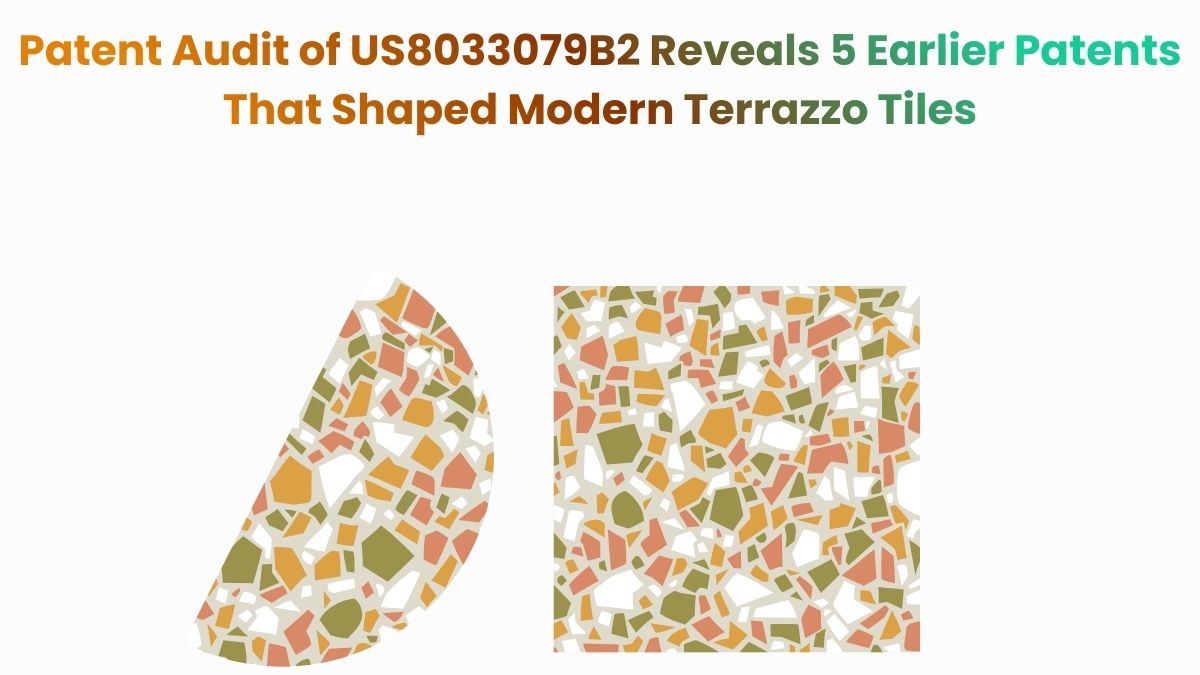Electropolishing may seem like a niche process, but innovations in this field can quietly influence multiple industries, from aerospace to medical devices. EP4249647A1 is one such patent.
This European patent introduces a distinctive approach involving solid electrolyte particles suspended in a non-conductive fluid. It’s currently named in an infringement action between Steros GPA Innovative S.L. and OTEC Präzisionsfinish GmbH, but that’s not our focus here. What matters is the technical direction this patent represents, and how similar ideas may have surfaced in earlier filings.
Using the Global Patent Search (GPS) platform, we investigate patents that echo the core mechanisms described in EP4249647A1. Rather than framing this as a legal issue, we treat it as a research opportunity grounded in data, comparison, and claim-level insights.
The goal is to understand whether key elements of this patent, like the structure of the medium or the process flow, appear in earlier documented technologies. If you’re exploring innovations in surface finishing or evaluating overlaps in electropolishing methods, this is a structured review worth diving into.
Understanding Patent EP4249647A1
Patent EP4249647A1 discloses an electrolytic medium, an electropolishing process, and a device to carry it out. The invention introduces a unique combination of solid electrolyte particles that retain a conductive solution and a non-conductive fluid that suspends those particles. This medium is designed to conduct current through particle contact points while isolating the metal surface from unwanted acid exposure and oxidation, allowing for more precise surface polishing.

Source: Google Patents
Its Four Key Features Are
#1. Electrolytic medium made of solid particles retaining a conductive solution, suspended in a non-conductive fluid.
#2. Non-conductive fluid that coats the metal surface, minimizing corrosion and localized acid attack.
#3. Electropolishing process that applies current through particle-metal contact points under controlled movement and voltage.
#4. Polishing device designed to operate by immersion or blasting, maintaining electrical contact and mechanical flow.
Related Read: Electropolishing boosts corrosion resistance in piping. US10391344B2 and similar patents on Sprinkler Air Venting Systems improve fire suppression networks by reducing corrosion through smarter venting.
Similar Patents As EP4249647A1
To explore the innovation landscape surrounding EP4249647A1, we ran the patent through the Global Patent Search tool. Below is a quick glimpse of the GPS tool in action:
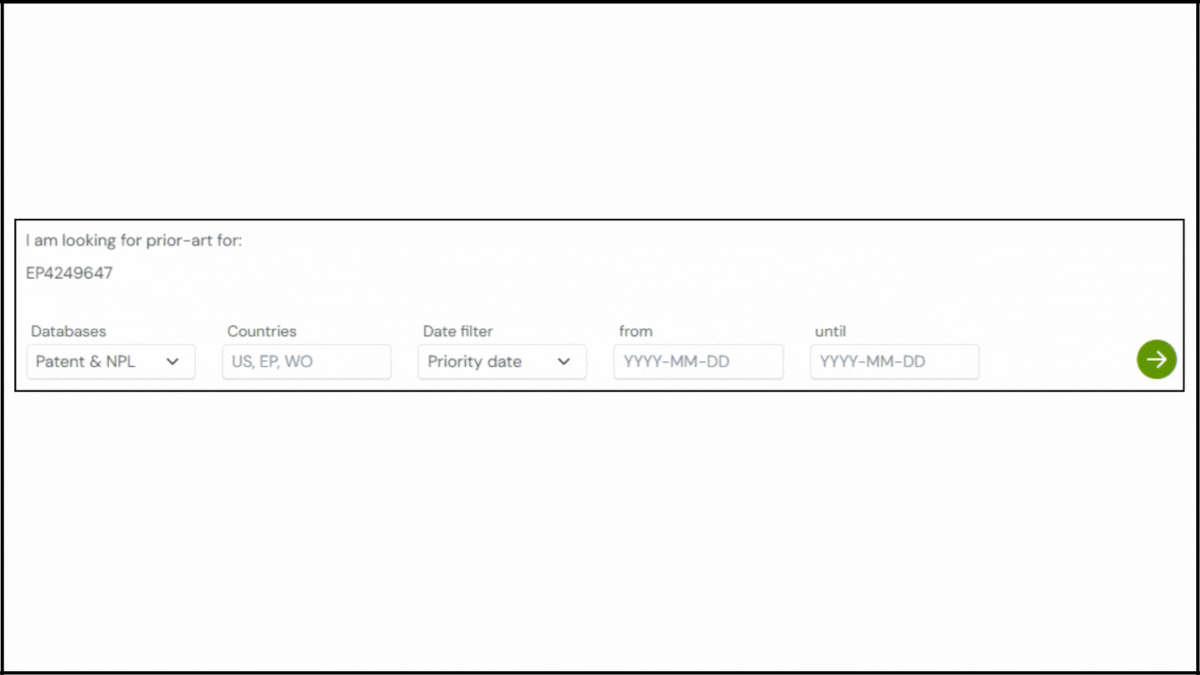
Source: Global Patent Search
This analysis surfaced a list of related patents that share technical similarities in electrolytic media design, electrochemical polishing, and surface treatment. Below, we highlight five of these references that reflect comparable ideas in controlled metal finishing systems. These examples offer insight into how similar challenges have been addressed across different applications.
#1. US2018290212A1
This US patent, US2018290212A1, published in 2018, describes an electropolishing technique using a permeable dielectric spacer layered between a metal surface and an electrode. The electrolyte is infused into this non-conductive spacer, allowing controlled current flow and enabling surface treatment on complex internal geometries, including heat exchanger passages.
Below, we have added snapshots from the GPS tool highlighting the relevant snippets from the specification for the similar patents.
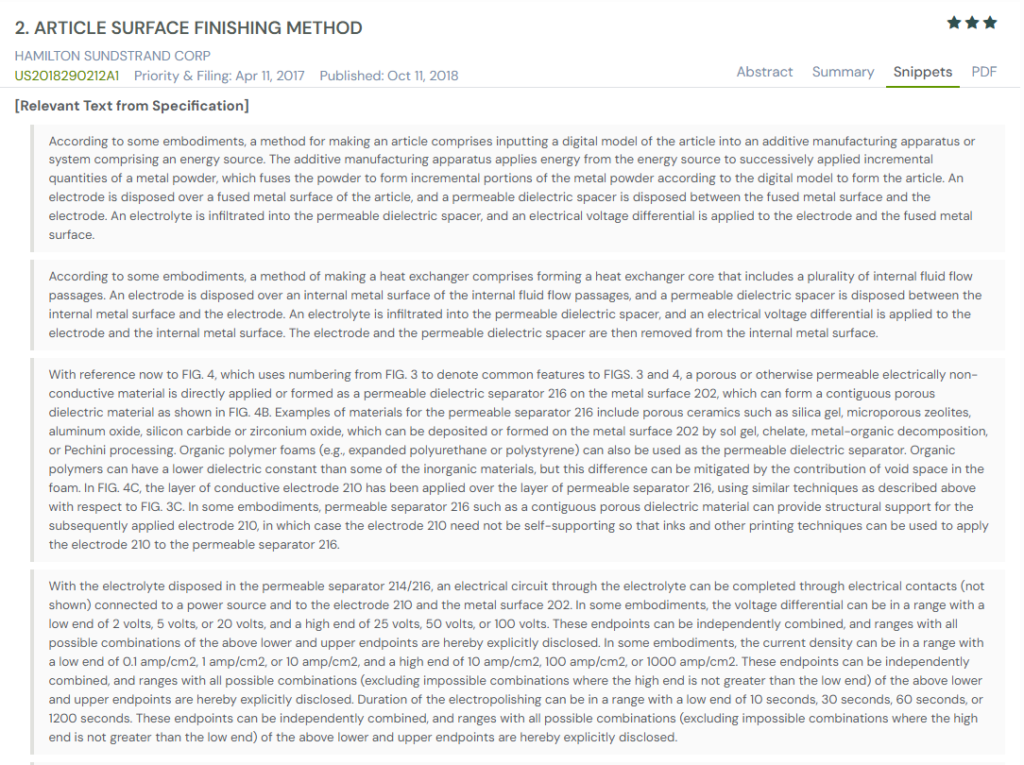
What This Patent Introduces To The Landscape
- Dielectric spacer-assisted electropolishing: Uses non-conductive porous materials such as ceramics or polymer foams to localize electrochemical action.
- Targeted surface treatment for internal cavities: Designed for polishing complex internal structures in a single stage without multiple processing steps.
- Electrolyte infiltration and voltage control: Enables precise current application through an infused porous layer, minimizing unwanted surface damage.
- Integration with additive manufacturing: Allows polishing to occur during or after part fabrication, reducing equipment handoffs and increasing efficiency.
How It Connects To EP4249647A1
- EP4249647A1 also focuses on localized electropolishing by regulating the interface between the metal and the active medium.
- While EP4249647A1 uses solid electrolyte particles in a non-conductive fluid, US2018290212A1 uses a porous dielectric spacer.
- Both approaches achieve selective material removal with better control and finish quality.
Why This Matters
This earlier work showcases how non-conductive intermediaries, whether fluid or solid, can enhance the precision and efficiency of electropolishing. It complements the concept of EP4249647A1 by offering an alternate strategy to minimize surface defects and target fine features, particularly in advanced manufacturing settings.
#2. ES2831105A1
This Spanish patent, ES2831105A1, published in 2021, outlines a system for electropolishing multiple metal pieces simultaneously using solid electrolyte particles in a gaseous medium. The process requires no firm fastening and ensures polishing occurs only at the contact points between the particles and the metal surface.
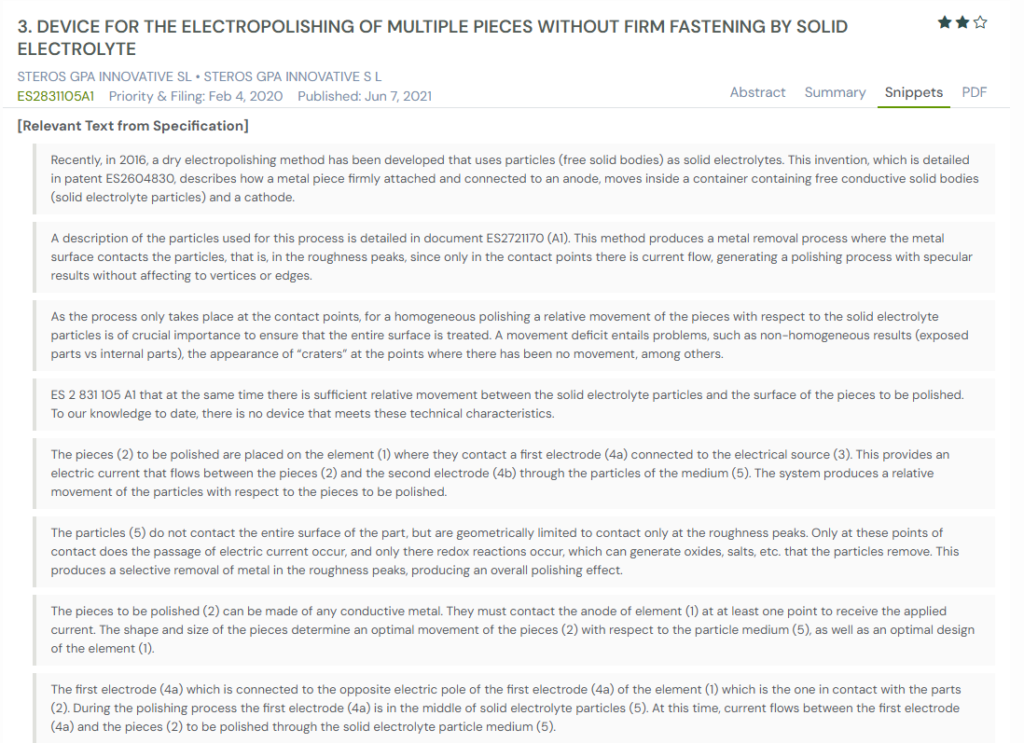
What This Patent Introduces To The Landscape
- Electropolishing without firm fastening: Allows multiple metal pieces to be polished simultaneously while loosely placed inside the polishing unit.
- Solid electrolyte particles in a dry medium: Uses spherical, sulfonated gel particles that retain acidic liquid and conduct electricity through contact points.
- Selective redox reactions at roughness peaks: Electropolishing occurs only at particle-metal contact zones, improving surface finish without damaging edges.
- Customizable particle media: Supports various acid compositions and particle shapes for different metal types and desired finishes.
- Integrated vibration system: Uses vibrators to fluidize the particle medium and maintain consistent contact and movement.
How It Connects To EP4249647A1
- Both use solid electrolyte particles that retain conductive solutions to perform targeted electropolishing.
- EP4249647A1 suspends these particles in a non-conductive fluid, while ES2831105A1 operates in a gaseous medium.
- Each design emphasizes localized electrochemical action at surface contact points, aiming for precision and minimal material loss.
Why This Matters
This reference illustrates how particle-based polishing systems can function without rigid fixturing or liquid immersion. It complements EP4249647A1’s controlled polishing approach and reinforces the role of media engineering in achieving uniform, selective finishes.
#3. US2022372648A1
This US patent, US2022372648A1, published in 2022, presents a solid electrolyte formulation for dry electropolishing of metals. It combines ion-exchange resin particles containing acid solutions with specially designed moderating particles that control electrical and chemical activity to prevent defects like craters or surface undulations.

What This Patent Introduces To The Landscape
- Dual-particle electrolyte system: Combines active resin particles with non-conductive and/or chemically neutral moderating particles to regulate polishing intensity.
- Targeted surface protection: Prevents unwanted patterns like “orange peel” effects and craters, particularly on sensitive or non-passivating metals.
- Neutralizing chemical exudates: Introduces basic solution-containing particles to counter acid exudates at the point of contact.
- Conductivity moderation: Uses non-conductive particles to create “electrical shadows” that temporarily block current and allow chemical cleaning.
- Abrasive-enhanced cleaning: Incorporates abrasive moderating particles to remove oxides and surface build-up without altering electropolishing parameters.
How It Connects To EP4249647A1
- Both patents aim to optimize localized electropolishing using solid electrolyte media that retain acidic solutions.
- EP4249647A1 uses a non-conductive fluid as a carrier, while US2022372648A1 employs solid-state moderation via particle composition.
- Each invention targets precision surface finishing through carefully managed electrochemical interactions.
Why This Matters
This reference expands the dry electropolishing field by addressing limitations in finish quality. It complements EP4249647A1 by showing how solid media design and electrochemical moderation can produce smoother, defect-free surfaces, especially on metals prone to sensitivity or passivation challenges.
#4. DE202017007607U1
This German utility model, DE202017007607U1, published in 2023, presents a method for smoothing and polishing metals through ion transport using free solid particles in a gaseous medium. These porous, conductive particles are designed to absorb electrolyte liquid below saturation, enabling surface treatment without pooling liquid.
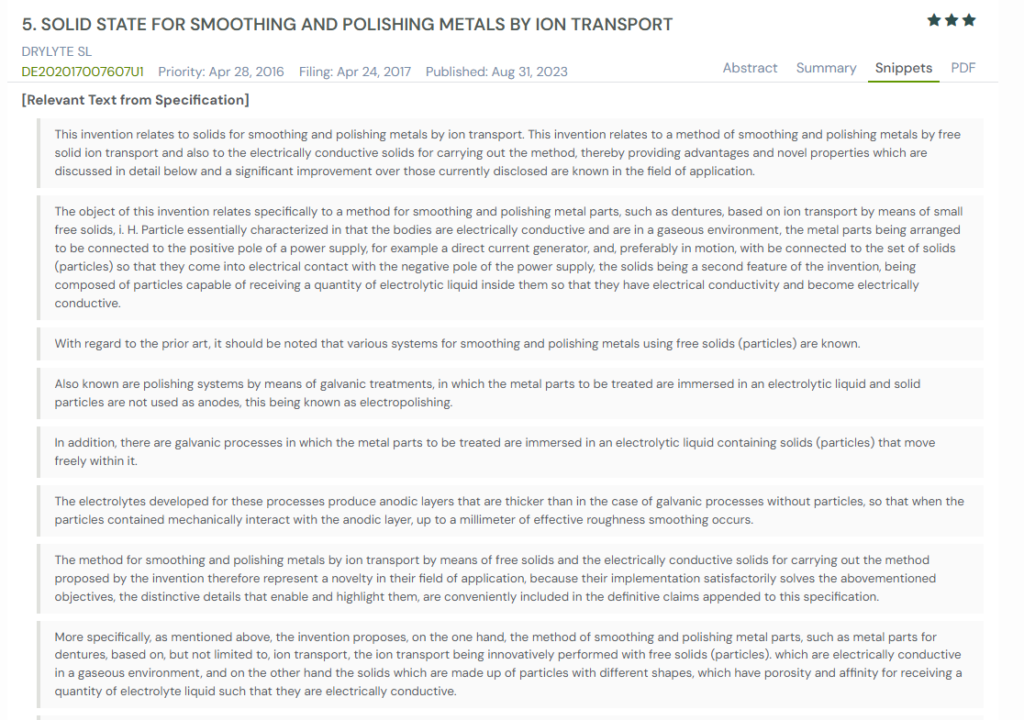
What This Patent Introduces To The Landscape
- Ion transport using free solid electrolytes: Describes a dry electropolishing method using porous particles in a gaseous medium to enable ion movement between anode and cathode.
- No free liquid on surfaces: Ensures electrolytic liquid remains inside particles, avoiding unwanted pooling or over-saturation effects.
- Direct-contact electric bridges: Allows particles to form temporary electrical bridges between metal parts and the cathode, enhancing electropolishing.
- Electroerosion at roughness peaks: Enables localized metal removal through wetting and electrochemical interaction at surface high points.
- Parameter control flexibility: Offers full adjustability over voltage, particle-to-gas ratio, and electrolyte composition for tailored polishing outcomes.
How It Connects To EP4249647A1
- Both use solid electrolyte particles as the medium for controlled electropolishing action.
- EP4249647A1 suspends particles in a non-conductive fluid, while DE202017007607U1 uses a gaseous environment.
- Each targets localized surface smoothing via electrical current passing through discrete contact zones.
Why This Matters
This method reinforces the potential of dry particle-based electropolishing as an alternative to traditional liquid systems, mirroring innovations from green tech leaders working toward sustainable manufacturing. It supports EP4249647A1’s concept of precision surface finishing while demonstrating the advantages of tuning electrolytic environments for sensitive or detailed parts.
#5. RU2815259C1
This Russian patent, RU2815259C1, published in 2024, describes a device for electropolishing multiple freely moving metal parts using solid electrolyte particles in a gaseous medium. It emphasizes selective metal removal at roughness peaks via controlled electrical contact through a dual-electrode system.

What This Patent Introduces To The Landscape
- Multi-part electropolishing without fixation: Allows simultaneous treatment of several metal pieces without requiring them to be fixed in place.
- Solid electrolyte in gaseous environment: Uses ion-exchange resin particles with retained acidic liquid to enable dry polishing without bulk liquid.
- Controlled electrical contact via electrode configuration: Uses a top and bottom electrode arrangement with polarity-switching capability.
- Selective redox reactions at contact points: Ensures polishing only at roughness peaks, preserving part edges and intricate geometries.
- Vibration-based particle motion: Incorporates vibration elements to ensure uniform movement and contact between particles and parts.
How It Connects To EP4249647A1
- Both systems use solid electrolyte particles that retain a conductive solution to facilitate polishing.
- EP4249647A1 suspends the particles in a non-conductive fluid, whereas RU2815259C1 uses a gaseous medium with vibration-driven motion.
- Each method targets precision polishing through selective surface interaction and controlled current flow.
Why This Matters
This invention shows the adaptability of dry electropolishing systems for batch treatment without fixturing. It supports EP4249647A1’s goal of efficient, localized surface treatment, reinforcing the role of particle dynamics and electrical control in modern finishing technologies.
How to Find Related Patents Using Global Patent Search

Understanding the broader patent landscape is key when exploring innovations in electropolishing, dry surface treatment, or metal finishing systems. The Global Patent Search tool streamlines this process, helping users identify technologies that reflect similar particle-based or electrolyte-controlled polishing mechanisms.
1. Enter the patent number into GPS: Start by entering a patent number like EP4249647A1 into the GPS tool. The platform transforms it into a smart query, which you can refine using terms like solid electrolyte, dry electropolishing, or surface smoothing.

2. Explore conceptual snippets: Instead of comparing features claim-by-claim, GPS now offers curated text snippets. These highlight how other systems control surface reactions, distribute electrolytes, or target roughness peaks for material removal.
3. Identify related inventions: The tool reveals patents that tackle dry polishing, electrolyte particle design, or electrochemical control, showing how related challenges have been addressed over time.
4. Compare systems, not legal claims: Rather than focusing on formal legal language, GPS compares system behaviors. This helps users trace functional overlaps, like particle contact zones or voltage-controlled surface reactions, without navigating legal boundaries.
5. Accelerate cross-domain insights: Whether you’re working in medical device finishing, aerospace components, or 3D-printed construction technologies, GPS lets you uncover related ideas across technical domains that may otherwise be hard to connect.
Global Patent Search empowers technical teams to move beyond claim language and explore how systems truly function across related inventions. It helps uncover subtle overlaps, improve innovation tracking, and support faster, data-driven decisions in both R&D and IP strategy.
Disclaimer: The information provided in this article is for informational purposes only and should not be considered legal advice. The related patent references mentioned are preliminary results from the Global Patent Search tool and do not guarantee legal significance. For a comprehensive related patent analysis, we recommend conducting a detailed search using GPS or consulting a patent attorney.

